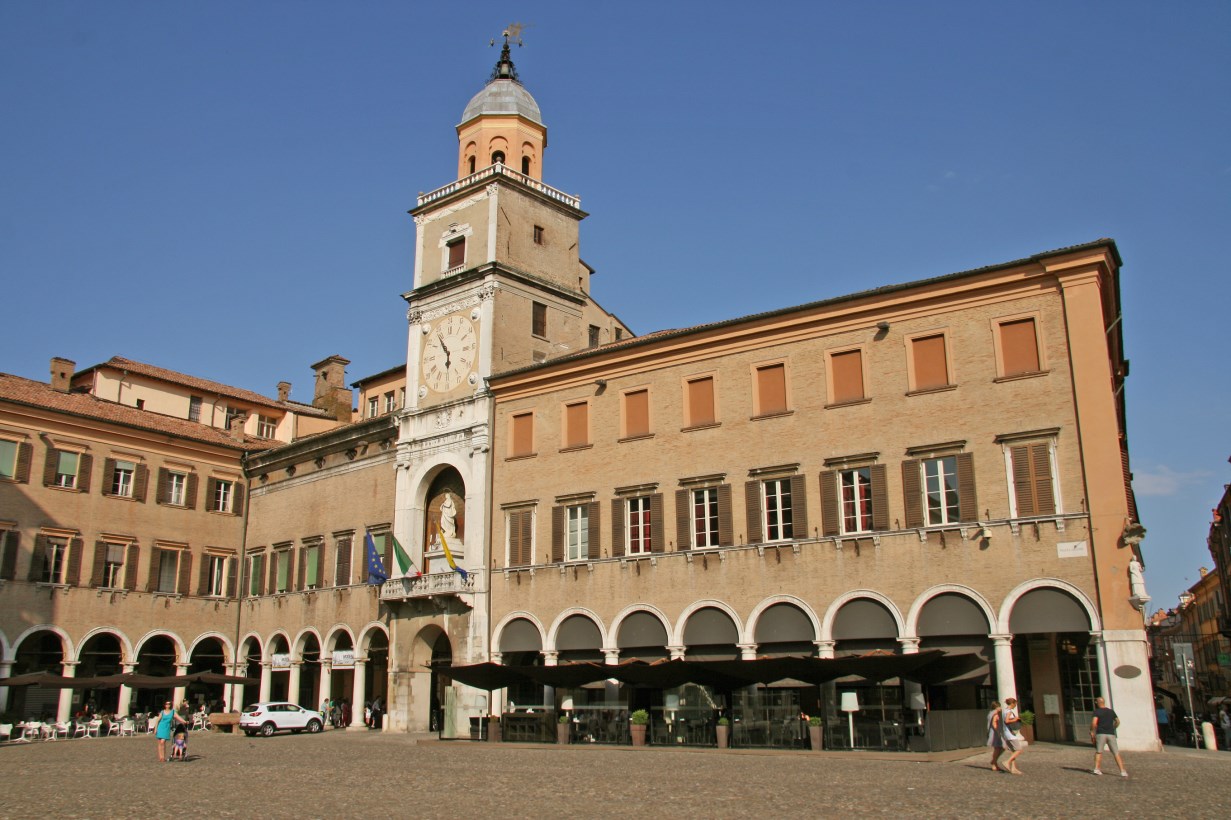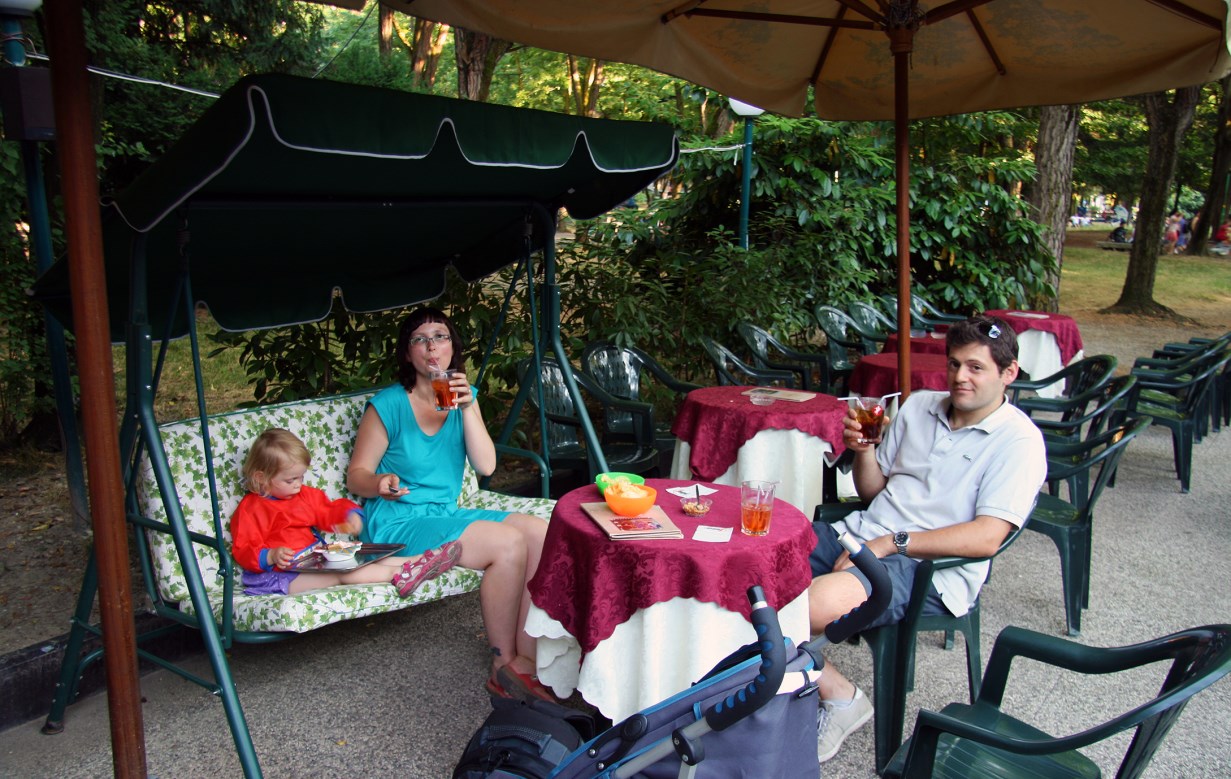We visited the Italian island of Sardegna (Sardinia) in the summer of 2013. We combined our stay there with a roadtrip from our home in Belgium to the island (and back), passing through France, Switzerland, and Italy. Along the way, we visited a number of world heritage sites and every evening we stayed with a different couchsurfing host.
The day before we had to take the ferry to Sardegna, we arrived at Modena. I must admit it was a city we didn’t really know much about, except for the fact that it has a UNESCO-listed cathedral and tower.
We decided to let it surprise us, and it did! It was a warm and sunny, late afternoon when we parked the car somewhere near the Palazzo dei Musei, and headed to the Piazza Grande, where Mirco, our local couchsurfing host, was waiting for us.

The Piazza Grande
This is the central square of the town. The square itself is listed as UNESCO world heritage, as well as several buildings lining it. The central buildings here are the 11th-13th-century cathedral and the 13th-century gothic campanile called the Torre della Ghirlandina. Both are constructed with light-coloured Istrian stone. The cathedral is a superb example of a romanesque church, built by the architect Lanfranco. The building is beautifully ornamented with numerous sculptures by the sculptor Wiligelmo. The biblical figures of the portals are fine examples of his talent.
We went completely around the cathedral and it’s difficult to say from which angle it is most beautiful… We (including Febe) especially loved the lions guarding the cathedral’s portals.
The campanile
The monumental Ghirlandina bell tower is the highest building in the city centre. It is closely linked to the cathedral by two arches. It consists of a multi-storey rectangular base, an octagonal drum and an upper lantern.














The town hall
Facing the Piazza Grande, the 17th-18th-century town hall is characterised by a robust clock tower. Above the porch of this Palazzo Comunale, the 13th-century statue “La Bonissima” is installed.


Away from the centre
Our host Mirco showed us around town and turned out to be the perfect city guide. After our tour around the cathedral and its campanile, he lead us further away from the centre. We noticed the remarkable street name plates (e.g. “Corso Canal Chiaro”, “Corso Canal Grande”…), witnesses of the times that Modena had a closely-knit network of navigable canals instead of roads (comparable to Venice).
Away from the city centre, along the Viale delle Rimembranze, there is a park where you can relax a bit, drink a cocktail, eat some icecream… Children can even hop on a tiny train for a thrilling ride.
Mirco also showed us the 12th-century university building. The University of Modena and Reggio Emilia is one of the oldest in Italy.




Sports car industry
Modena is not only well-known for its historical buildings. The factories of famous Italian sports car makers such as Ferrari, De Tomaso, Lamborghini, Pagani and Maserati are, or were, also located here. This also means you could suddenly come across one of these supercars in the city, for example when the factory owner is taking his Pagani Zonda for a ride…

Culinary tradition
Modena’s most famous product is, without any doubt, its superb Balsamico vinegar. As a proud inhabitant of Modena, our host Mirco also makes his own Balsamico at home. It is a process that takes many years for the vinegar to be at its best. But the end product is just incredible: a sweet/sour, dark brown sirup that can be used, for example, with a selection of local meats and other antipasti. It is in no way comparable to the Balsamico vinegar we buy in our local (Belgian) supermarket, which is much more liquid and sour. Don’t be surprised when you see the price, though: it’s a top product after all…
Traditionally, Italian restaurants do not open before 21 p.m., so we had to wait a bit before we could eat. Mirco took us to a great restaurant near the Synagogue, where we enjoyed some local specialities. Obviously, the Balsamico was omnipresent 🙂

Cathedral, Torre Civica and Piazza Grande, Modena (nr. 827)
The complex around the Piazza Grande in Modena is a fine example of the intricate relationship between architecture and sculpture in the Romanesque art of the 12th century. Moreover, this architectural complex closely combines religious and civic values in the medieval town centre. Construction of the cathedral and the Ghirlandina bell tower took place in an urban structure already largely formed. The combined efforts of the architect Lanfranco and the sculptor Wiligelmo resulted in this architectural and artistic masterpiece. The first phase of building took place at the end of the 11th century. In the 12th century, two side portals and the rose window in the facade, as well as the wonderful Porta Regia on the southern side, were added. The cathedral and the campanile are closely linked by two arches. Both structures are also indivisible in both physical and stylistic terms. The use of Istrian stone and Romanesque details give them the splendour of the temples of antiquity. In contrast, the octagonal drum and upper lantern of the Ghirlandina express a new feeling of the Maestri Campionesi for Gothic architecture. Modena Cathedral was also a large sculpture workshop, brilliantly illustrated by Wiligelmo. Only minor changes have been made to the Piazza Grande. The old and new Palazzi Comunali were connected by the clock tower (13th to 16th centuries) and blended in by the means of new facades and arcades (17th to 19th centuries).




